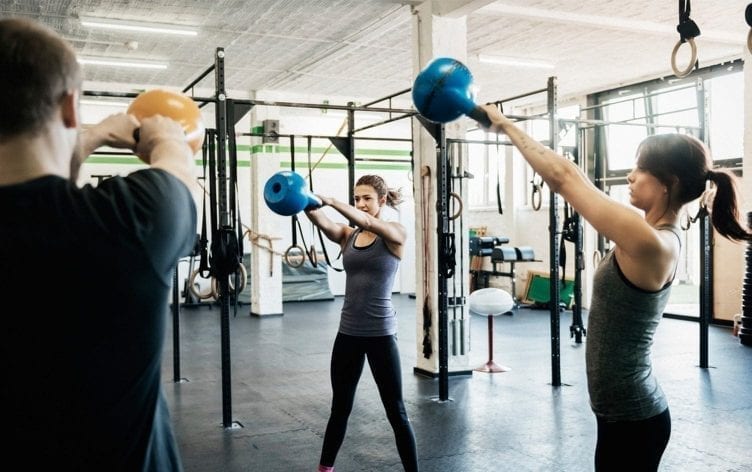
It’s no surprise kettlebell training is on the rise. There’s a good reason: Everyone can benefit from kettlebell exercises. “The kettlebell is an extremely versatile piece of exercise equipment that can be used for Olympic-style training, strength training, HIIT and mobility,” says Colin Laughlin, a certified strength and conditioning coach.
Kettlebells have a unique shape that lets you blast your body in ways dumbbells can’t. You can pull, push, twist and swing them to get leaner, stronger and more powerful. Plus, they’re easier on your wrists than dumbbells. Also, because of their offset weight, the gravitational pull goes straight down, instead of from side-to-side with a dumbbell (which is shaped like a teeter-totter).
Plus, kettlebells are incredibly convenient. “One kettlebell can, in some ways, replace an entire gym if you are creative enough,” says Grayson Wickham, DPT, a physical therapist and founder of Movement Vault. “When you add a few different kettlebell weight options into the mix, your workout capabilities are endless. During this quarantine time in New York City, my apartment gym has consisted mostly of my five different-weighted kettlebells.”
When it comes to creating a training plan, there’s one key rule to live by: Keep it simple. “Master the basics first and then make them better,” recommends Matt Bahen, a certified strength and conditioning coach and owner of S3E Performance Fitness.
Here are 10 must-know kettlebell exercises to try — straight from expert trainers.
1
KETTLEBELL DEADLIFT

“Learning how to properly pick things up from the floor and put them back down safely is a must-have life skill,” Bahen says. Deadlifts work to strengthen some of the body’s biggest muscles — your hamstrings and your glutes — which helps increase your metabolic rate, according to Laughlin.
The move: Start with the kettlebell on the ground and the handle in line with your ankles. With a soft bend in your knees and straight arms, send your butt back (like you’re trying to close a drawer with it) until you can grab the handle. Grab the handle with both hands, and imagine you have a piece of paper underneath each armpit that you want to keep there as you stand up. Reverse the motion with your hips to come up, and repeat.
2
KETTLEBELL GOBLET SQUAT
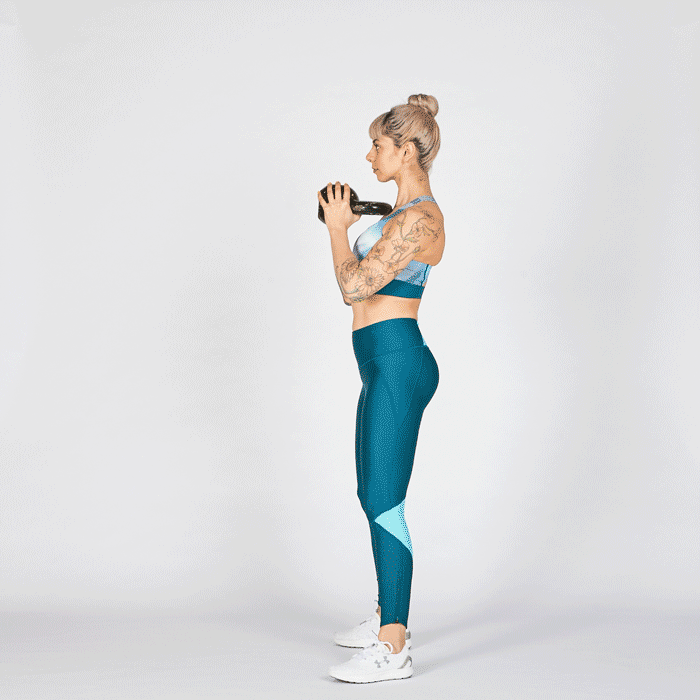
Similar to the deadlift, the squat is a major functional movement. “I specifically like the goblet squat because you have to control the weight in front of your body, which increases the demand on your shoulder, core and quadriceps muscles,” Wickham says.
The move: Hold the kettlebell with both hands in front of your chest, just under your chin. Send your hips back and down as you squat as low as you can comfortably. Imagine you’re spreading the floor apart with your feet as you stand up.
3
KETTLEBELL SWING

“This is the almighty kettlebell exercise,” Wickham says. It works your power, speed, strength, coordination and cardiovascular fitness all at the same time, he adds.
The biggest mistake people make with kettlebell swings, according to Wickham, is treating the exercise like a squat, using the bending and straightening of their knees to drive the swinging motion. Instead, focus on initiating the movement with your hips.
The move: Place the kettlebell on the ground in front of you. With your knees slightly bent and arms straight, reach forward and grab the kettlebell by the handle, hiking it back between your legs. Then snap your hips and squeeze your butt to come up to a standing position. Throughout the exercise, keep your core muscles engaged.
4
KETTLEBELL GOBLET STEPUPS
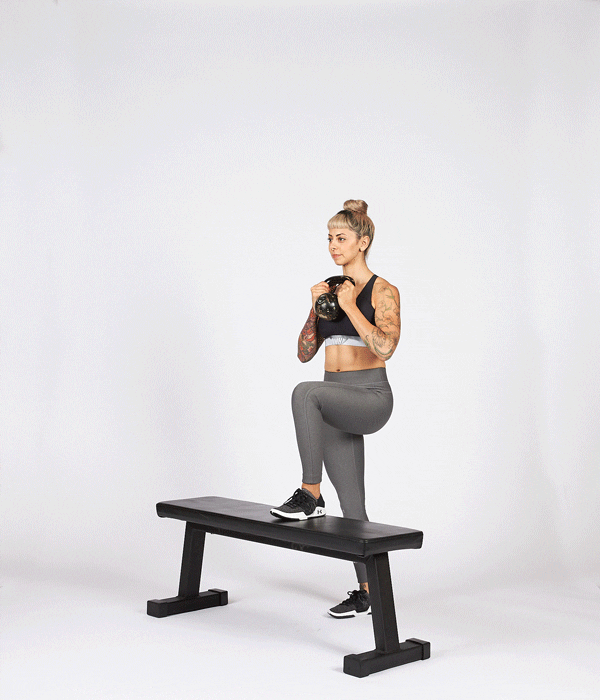
“Most people have a dominant leg that is stronger than the other,” Laughlin says. “Working one leg at a time ensures that each leg is strengthened equally.”
The move: Holding the kettlebell in front of your chest, step onto a sturdy bench or box, driving through your elevated foot. Come back down and repeat.
5
KETTLEBELL CURTSY LUNGE

Wickham says this exercise takes the standard lunge and adds a rotational component, demanding more hip mobility and stability. It’s an ideal exercise for targeting the glutes, particularly when you don’t have access to a lot of equipment.
The move: Start in a standing position, either holding the kettlebell in front of your chest with both hands, or in a front rack position, resting against your forearm on one side. Step one foot back behind you and to the side, at a 45-degree angle (if you’ve chosen a front rack position, step the foot opposite the kettlebell back). Keeping both hip bones pointing straight forward, push through the front foot to return to the starting position.
6
KETTLEBELL PUSH-PRESS
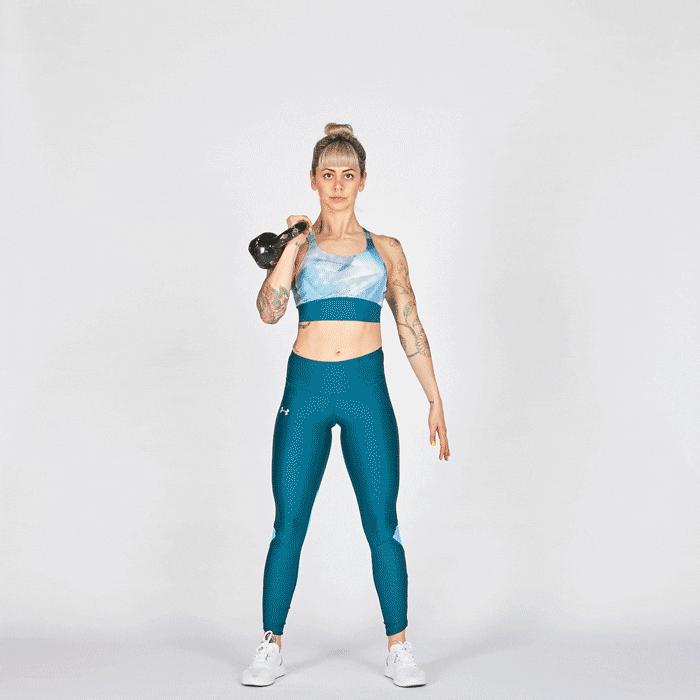
“This exercise allows you to work on your shoulder strength and power,” Wickham says. “You can go a little bit heavier than you could typically go with a strict press, as you will be able to use the momentum from your lower body drive to help push the weight overhead.” Wickham especially likes the single-arm variation of this exercise, since it requires more core and shoulder stability.
The move: Start with the kettlebell in the rack position. Keeping your wrist straight, dip into a shallow squat. As you stand up, drive through your legs, extend your arm straight up over your head, and keep your bicep in line with your ear.
7
KETTLEBELL SINGLE-ARM BOTTOMS-UP PRESS
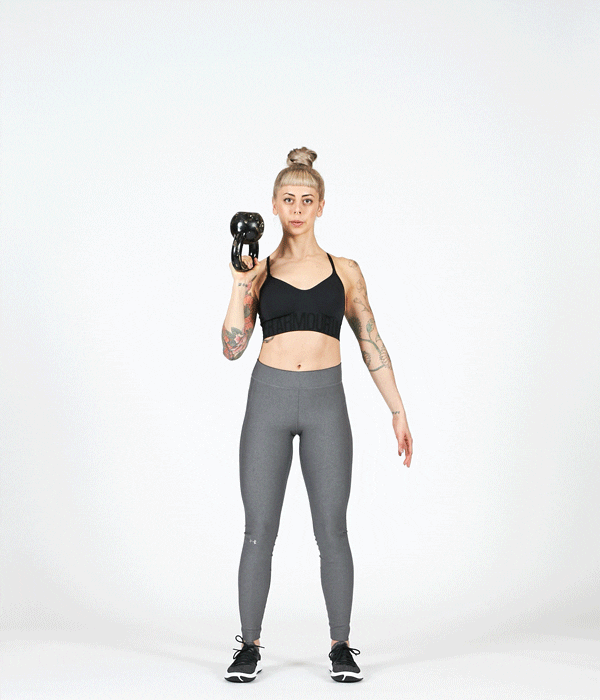
This is an ideal exercise for increasing strength and stability in your wrist and rotator cuff muscles, Wickham says.
The move: Using a light kettlebell, flip the bell upward so you’re holding onto the handle from the bottom. Hold your fist in front of your shoulder with your arm bent. Squeeze the handle as hard as you can, and press the kettlebell directly up until your arm is straight, and your bicep is next to your ear. Return to the starting position in a slow, controlled manner.
8
SPLIT-STANCE KETTLEBELL ROW
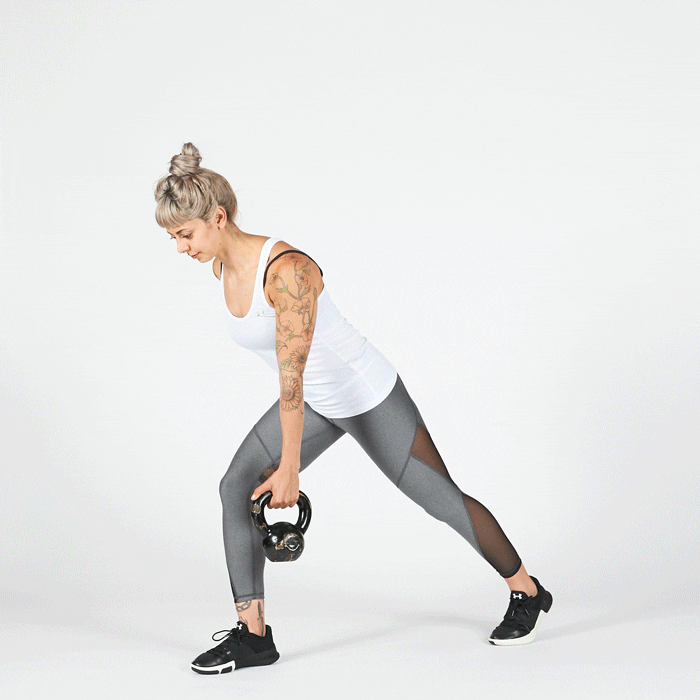
“The row is a vital exercise for creating strong and healthy shoulders,” Laughlin notes. Performing it in this position also works your core.
The move: Holding the kettlebell in one hand, step the same leg behind you. Shift your chest forward, forming a straight line from the top of your head to your back heel. Keeping your core tight, imagine you’re pulling your thumb toward your armpit.
9
SINGLE-ARM KETTLEBELL FARMERS CARRY

“This is one of the most underrated exercises, period,” Wickham says. In fact, he recommends performing it at least once a week. “It’s an amazing exercise for creating a strong and stable midsection, which will help you maintain a healthy and stable low back.”
The move: Hold the kettlebell in one hand, and walk in a straight line. Keep your chest up, shoulders slightly back, and arm close to (but not touching) your body. Repeat on the other side.
10
KETTLEBELL HALF-KNEELING HALO
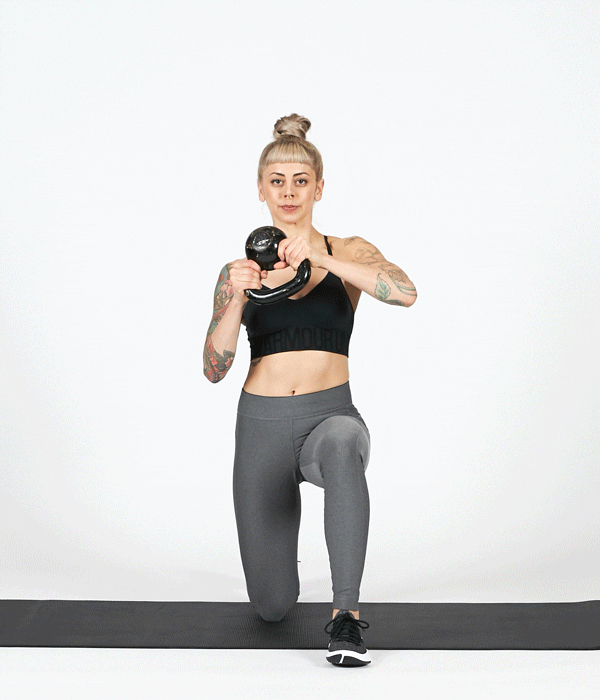
“The kettlebell halo is great because it works your shoulders in all three planes of motion including the sagittal, frontal and transverse planes — which means it works your shoulders front to back, side to side and rotationally,” Wickham says. It’s also an amazing core stability challenge.
The move: Hold the bell of the kettlebell (the round part) in your hands. Imagine you’re drawing a circle around your head with the bell while keeping your rib cage down and core muscles engaged.
Originally published May 2017, updated with additional reporting



